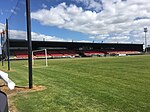Albion Viaduct

The Maribyrnong River Viaduct (also known locally as the Quarter Mile Bridge) carries the Albion–Jacana railway line, Melbourne across the Maribyrnong River in the western suburbs of Melbourne, Australia. It is located near the E J Whitten Bridge, and is almost 400 metres long (hence the Quarter Mile name). It was built in 1927–29 by the Victorian Railways Construction Branch, being the largest trestle bridge in Australia when completed in June, 1929. Until the completion of the Sydney Harbour Bridge, the viaduct was also the highest railway bridge in Australia. It employed 200 people during its construction, with one fatality, and is listed on the Victorian Heritage Register.With a length of 383 m (1,257 ft), and a height of 55 m (180 ft) above the water level, it is the second-highest bridge in Victoria after the West Gate Bridge (58 metres) The main traffic over the bridge is freight services, but it also carries two passenger services, the Melbourne to Sydney NSW TrainLink XPT, and the Melbourne-Albury V/Line service which now runs on standard gauge.
Excerpt from the Wikipedia article Albion Viaduct (License: CC BY-SA 3.0, Authors, Images).Albion Viaduct
Maribyrnong River Trail, Melbourne Keilor East
Geographical coordinates (GPS) Address Nearby Places Show on map
Geographical coordinates (GPS)
| Latitude | Longitude |
|---|---|
| N -37.748055555556 ° | E 144.8455 ° |
Address
Maribyrnong River Trail
Maribyrnong River Trail
3034 Melbourne, Keilor East
Victoria, Australia
Open on Google Maps







